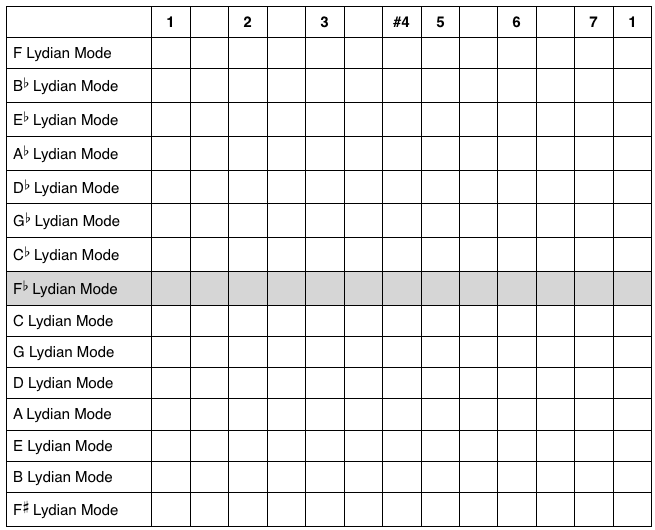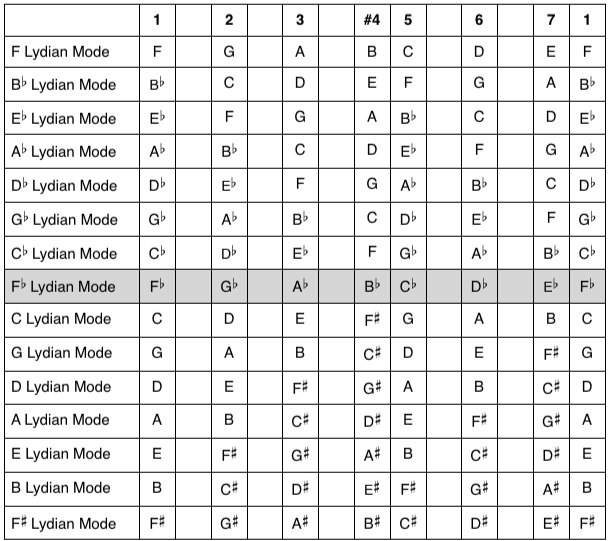In this guitar lesson, and the next lesson, we’re going to start exploring the lydian mode, which is a scale used extensively by rock guitarists like Joe Satriani and Steve Vai. So if you like both of these players, then pay close attention to what we’re about to cover. Even if you don’t like Mr Vai and Mr Satriani, it’s still a good idea to pay attention. 🙂
Although I’ll be giving you a practical application exercise nearing the end of the lesson, it’s really important that we first cover how the lydian mode is constructed. This way, you’ll have the confidence to work out the notes of any lydian mode that you might want to use in the future.
Musical Spelling Of The Lydian Mode
Like all scales, the lydian mode has it’s own unique musical spelling. The interesting thing about the lydian mode is that the spelling is almost the same as the major scale…
![]()
As you can see, the lydian mode has the same spelling as the major scale, except it’s got a #4. (This scale degree number is pronounced “Sharp Four”).
How To Use The Musical Spelling Of The Lydian Mode
Because the musical spelling of the lydian mode is so similar to that of the major scale, it’s a pretty straightforward process using it’s spelling. Let’s go through an example, and you’ll be able to see what I mean…
Example: C Lydian Mode
For this example, we’ll be working out the notes of the C Lydian mode. To do this, we need to follow these steps…
Step 1: Write down the notes of the C major scale. Doing this will give us these notes…

Step 2: Because the musical spelling of the lydian mode has a #4, this means that we have to raise the fourth note of the C Major scale by one half-step. If we do this, we end up with the notes of the C Lydian mode…

Pretty easy right? 🙂
Demonstration Video
On the following demonstration video, I quickly show you how to turn a major scale fingering into a lydian scale fingering. I also improvise a short solo to demonstrate to you how the lydian mode sounds in a musical context.
Now It’s Your Turn
Below is a table for you to fill out. What you’ll need to do is work out the lydian mode in all the possible keys. Because there’s a lot to work out, I really recommend only doing a few keys each day. This will make the process of filling out the table far less arduous, and the daily review will help you to learn the material better.
I should mention here that the Fb Lydian mode can’t be worked out using the two step method we’ve just talked about. (There is no Fb major scale). For this pesky key, the easiest way to work it out is to lower all of the notes of the F Lydian mode by one half-step.

Please don’t read any further until you’ve filled out the table. I’ll be giving the answers in the next section, so it’s important that you don’t skip ahead to cheat. 🙂
The Answers
Here are all the answers. Please take the time now to check that you filled the table out correctly. If you made any mistakes, then it’s important that you figure out where you went wrong.

Putting This Theory Into Practice
The lydian mode has a really cool sound that, to my ears, is very bright and majestic. But, it’s important that you work out your own description for the sound of the lydian mode. To help you do this, I’ve put together a little exercise for you to do. Here’s what you need to do…
- Below this list of steps is a useful single string fingering for the A Lydian mode. For this step, you’ll need to memorize the fingering I’ve written out. Keep in mind, you shouldn’t just mindlessly memorize the fret numbers. Make sure that you also commit to memory the note names and the scale degree numbers.
- Using the scale notes you’ve just memorized, improvise over the backing track that I’ve provided below. Listen carefully to the sound of all the notes you play, and be sure to target the D# note a lot. (This is the #4).
- After you’ve spent some time playing over the backing track, write down your own description of how you think the lydian mode sounds.

A Few Last Words
I hope you enjoyed this short introduction to the lydian mode. It’s one of my favourite sounding scales, and I think you’ll have a lot of fun with it. 🙂
Practice hard!
Return To: Guitar Music Theory Lessons